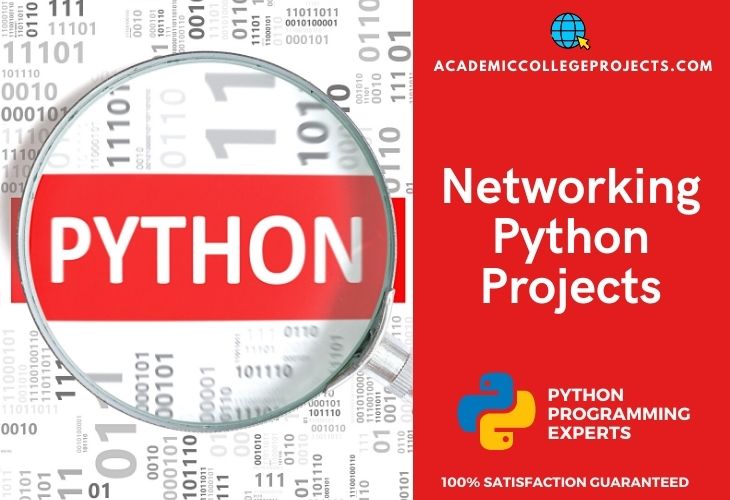This page definitely gives new updates on networking python projects with their current using libraries, tools, packages. Generally, Networking is defined as the learning of different networks that are used for communication purposes. Here, python has the key player role in developing networking projects. Since it has the capabilities to access the network in two different levels, one is low-level, and the other is high-level. In the low-level access, you can access the fundamental socket-oriented OS operations. This enables you to work with clients and servers that support both connectionless and connection protocols. In high-level access, you can work with an application that supports protocols like HTTP, FTP, and more. On the whole, python includes more in-built libraries to support you in both levels of access.
Which language is best for networking simulation?
For Networking, there are a very limited number of languages. So, it is preferred to choose the programming language that has greater functionalities and scope to carry over any kind of networking operations. In order to fulfil these needs, many languages were developed, but Python stands apart for implementing networking projects. However, there are more languages; some may find it hard to learn / code, some may lack incompatibility, some may not fails to meet your requirements, and more.
At that moment, python is largely preferred by global-level developers. Though it is designed for satisfying general purposes, it has the competence to handle network-related functions as mentioned above. Overall, beyond the general purposes, it supports more as an all-rounder. So, it gains more attention among developers for many reasons.
In recent developments, Python Toll for Visual Studio (PTVS) tool has become the best alternative solution for current Visual Studio (VS). It offers a sophisticated python enabled integrated development environment (IDE) for developers. Also, it is the open-source software that provides frameworks as combined C++/Python bug fixing, modifying, IPython IronPython, CPython, surfing, profiling, IntelliSense, remote Linux / MacOS debugging, web-based Django, and more. Below, we have included other characteristics of the networking python.
Key Features of Networking Python
- Enable to utilize python APIs using PY for a network analysis framework
- Flexible tool to develop real-time networking applications at multiple scenarios
- Support nearly 50+ datasets used for network-related functions such as integration of networks, internet systems, web graphs, citation networks, vehicular /social networks, data communication, etc.
- Allow developers to rapidly build the application on using python core libraries
- Provide cvxopt library to optimize the convex problems
- Able to capture the live online data from social networks using python interfaces. For instance: social media websites
- Provide different libraries such as Wireshark, binascii, tcpdump, and etc. for analyzing malware traffic in the network
- Ability to automate the network functionalities by utilizing python modules/libraries
- Due to the python infrastructure compatibility nature, it is supported in different operating systems like Windows, macOS, Andriod, Ubuntu, iOS, etc.
Next, we can see the advantage of using Python 3 since it is furnished with the adaptability of incorporating new technologies and tools. Further, it is also enriched in massive networking libraries, packages, modules, and more. So, it is one of the best choices of python developers.
Benefits of Python 3 in Networking
- Able to create a network configuration tool that helps to record the runtime network config variations by comparing historical information. Then, regularly inform the changes to the network admin
- Easy to construct the packet sniffer for collecting and inspecting network packets through ICP and ARP protocols. Then the collected information is safely stored in the log files.
- Monitors the real-time network performance and give the result in the graphical representation
- Enable to connect with all network entities through SSH. Then, let you read and write the different devices configurations
- Allow building the different networking tools that support LLDP, NMAP, OSPF, SNMPv3, and DHCP Servers
- Combine python 3 with specific modules to create the relation with query network devices through remote servers (Linux / Ubuntu)
- Extract the network resource utilization information by creating SSH session for each network entity
Now, we can see about the current networking research areas that give the best results while building their applications using python cyber security. We have experienced developers to help you in creating unbelievable contributions to new areas of the networking field. So, you can confidently hold your hands with us to create amazing networking python projects in your interested area.
Network Research Ideas Using Python
- Cognitive Radio Networks
- Use Wireless Testbed
- Enable to you to execute python enabled network applications in wireless network testbeds
- Use GNU Radio module
- Simple to develop real-time wireless networks applications (radio models)
- Basic Requirements
- Packages – beautifulsoup4, requests, sh, docopt and lxml
- Use Wireless Testbed
- Cellular Networks and IoT
- Use Mobly 1.5 framework (for automated testing)
- Easy to work with complicated structure of mobile / IoT applications
- Support end-to-end application test
- Basic Requirements
- Python – 2.7, 3.4 and above
- Operating System – MacOS 10.6 or above, Ubuntu 14.04 or above and Windows 7 or above
- Use Mobly 1.5 framework (for automated testing)
- Can Protocol
- Use Python-Can library
- Offer essential abstractions to various network devices. For instance: BeagleBone and Raspberry PI
- Adaptable with any developing environs library
- Installation Command – sudo pip install python-can
- Basic Requirements
- Linux kernels
- Versions – 2.6.25 and above with SOCKETCAN
- Windows
- Drivers – Kvaser’s CANlib, VCI V3 SDK and IXXAT’s
- Linux kernels
- Use Python-Can library
- Mobile Ad Hoc Networks (MANETs)
- Use Simple Network Simulator (sim2net)
- Event based discrete MANET network simulation tool
- Enable you to design and simulate user-specified number of nodes
- Move the nodes based on the given mobility model
- Transmit application message in custom based applications
- Installation Command – sudo pip install sim2net
- Use Simple Network Simulator (sim2net)
- Long Term Evolution Networks
- Use Pyltesim module
- Ability to design, test and deploy LTE / 4G applications
- Use PyLTEs framework
- Enable to validate and assess standards, tools, and techniques used in the LTE / 4G models
- Basic Requirements
- Packages – Scipy, Matplotlib, Numpy and pyipopt / ipopt
- Optional – virtualenv
- Use Pyltesim module
What we are going to discuss in this page?
Basically, networking python projects require installing other independent mechanisms for the application requirements such as intermediate infrastructure, network simulation tools, and network traffic simulators. Further, we also include the following to build networking applications
- Python APIs / Interfaces
- Management Tools for handling simulated network configuration
- Python Libraries for managing large-network related data (traffic)
As mentioned earlier, python has in-built large-scale libraries to work with all emerging networking technologies. Though these libraries are developed for general needs, from our field experience, we learned these libraries are more effective for network-related functionalities. For the sample, we have listed only a few for your reference. Beyond these libraries, we have familiarities with numerous libraries for implementing best networking python projects.
Which Python library is used for networking?
- WebScraping
- Script to capture the live web information (live video broadcast)
- NAPALM
- Library to automate the network devices communication
- Eddie
- Support various networking functions such as routing, offloading, resource allocation, etc.
- Asyncio
- Library to support event loop, asynchronous Input/Output and coroutines.
- Platform to write single-threaded concurrent code by means of socket based multiplexing I/O, coroutines and other resources
- LinkChecker
- Archive to verify the server-side operations
- Packet Capture Library–Pycap
- Package to combine the functionalities of libpcap file
- Netmiko
- Library to establish communication between network devices
In addition, we have also given you few popularly used Python Application Programming Interfaces (APIs). These python APIs have unique purposes and set of functions required for networking core operations. Further, we are ready to give more information once you tie up with us.
Python APIs for Networking
- Python APIs that support HTTP protocol
- nmap Tool
- Scan the network ports
- Socket programming
- Identify the System IP address (local)
- Python Interfaces and Google
- Extraction of the geolocation (using GPS)
- Python Package (index-PyPI)
- Software warehouse for high python packages
So far, we have discussed the python packages, libraries, and APIs. Now we can see about the add-on python plugins. These plugins are more suitable for recent networking research areas. Our developers are precise in choosing the appropriate plugins based on the project’s needs.
Additional Plugins in Python used for Networking
- Knock subdomain scan
- Utilizes the wordlist for scanning / monitoring sub-domains or specific-domain
- Dpkt
- Enable to create parsing / packet at high speed through simplest way
- Pytbull
- Offer test platform testing for IPS and IDS
- Dirtbags py-cap
- Allow to read pacp file (packet analysis) without the use of libpcap
- Mallory
- non-standard protocols support on the fly and it extends with TCP/UDP man-in-the-middle proxy.
- Flowgrep
- Represent the grep (regular expressions) through packet payloads
- Pcapy, Pypcap, Pylibpcap
- All these are various libpcap python archives or scripts or module
- Impacket
- Ability to decode network packets by utilizing high-level protocols (NMB and SMB)
- Libdnet
- Enable low level networking and communication operations. For instance: ethernet frame broadcast
Python based Network Simulation
Simulation is the best choice for developers to build and test the network before the direct deployment. Primarily, It simulates the network exactly the same as real network/testbeds with realistic traffics. By the by, it not only helps to simulate but also assesses the performance and behavior of the actual network through the simulated model. Based on the collected statistics reports, the developer can adjust the performance parameters for further improvements in networking python projects. Below, we have given you by what parameters one should select the python enabled simulation tool.
How to select the best python network simulation tools?
- Most important required characteristics – Selected scenario simulation and graphical simulation output
- Automate complicated network tasks. For instance: network/device configuration and interoperability
- User-friendly to import and configure other tools and simulate the network to get expected graphical results
- Cooperation in different networks simulation from design to result analyze phase
- Produce predefined simulation reports at the end of project execution
- Minimize the errors in network simulation and execution
To the end, we shared a few important pythons-enabled network simulation tools. Through these tools, you can write the python code for developing both real and non-real applications. It includes all fundamental libraries and APIs to develop any kind of application regardless of complexity for developing networking python projects.
Python based Network Simulation Tools
- Pure-Python (SNMP agents simulation tool)
- Mininet
- NS3
Overall, the above-specified python libraries, modules, supporting simulation tools are really effective to use. Still, now, we are using all these mechanisms and frameworks. Further, if you need more detail on the development of networking python projects, then make a bond with us. We will let you know more from us and clarify your doubts.



